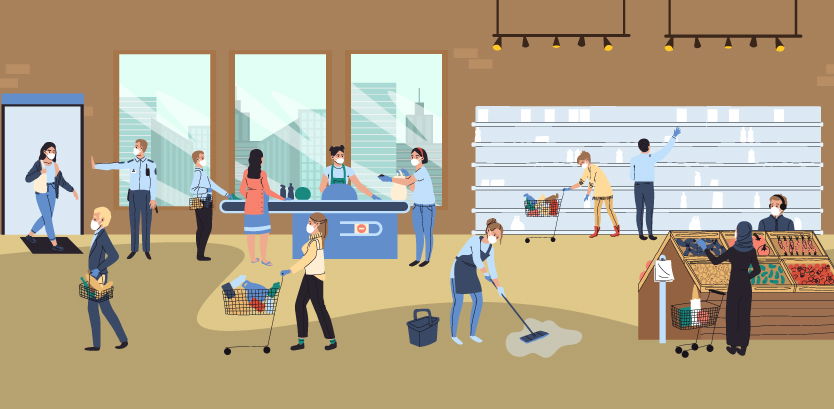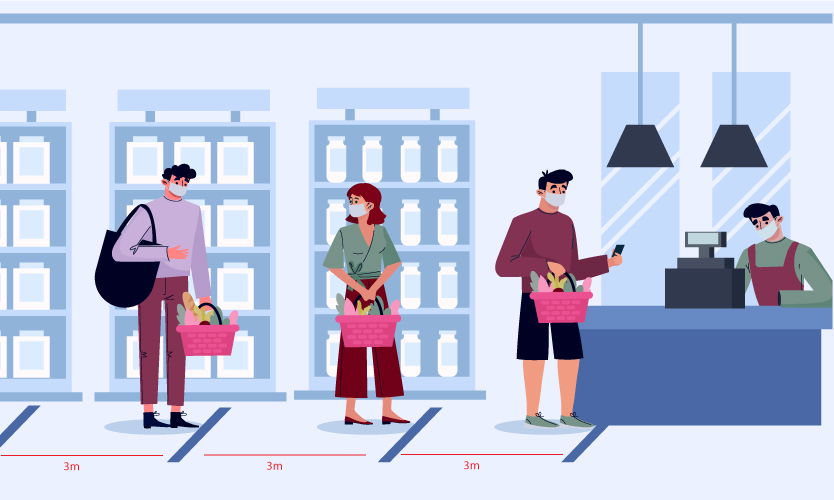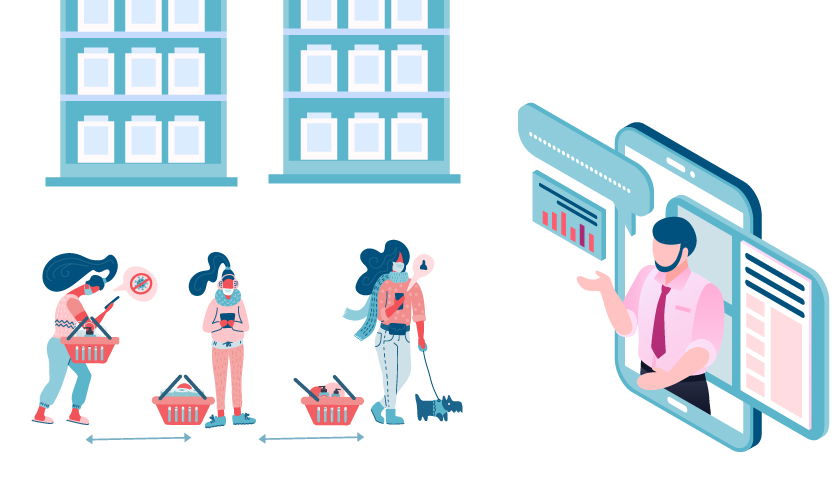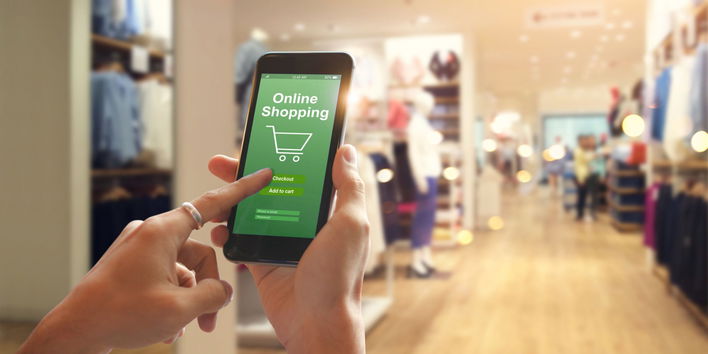With the rise in the number of users opting for online shopping, brick-and-mortar retailers have been changing their digital retail strategy. So, it doesn't come as a surprise when you discover that global e-retail sales amounted to 2.8 trillion U.S. in 2018. But that was two years before the world was introduced to the Covid-19 pandemic.
The scenario is changing, and even though supermarkets are reopening to boost the economy, the scare of COVID-19 is still in the back of shoppers' minds. So, what can retailers do to create a balance between shoppers' digital and physical worlds?
In this article, we will explain how technology can become a comprehensive part of implementing an in-store shopping experience in the digital retail strategy.
What is an in-store shopping experience?
Customers still value the in-store shopping experience. The ability to view, touch, and feel the product, the sounds, and scents are still part of the customers' shopping in-store and will remain the foundation of the retail industry.
Online shopping has disrupted the retail industry. However, customers still want to shop in brick-and-mortar stores. You cannot deny that people will always overspend their budget while shopping in-store while being online.
The effect of Coronavirus on the world economy is devastating. Although online commerce sales allowed a few retail businesses to stay afloat, it was not enough to offset losses caused by the slump in physical store sales.
Retail will see a $2.1 Trillion loss globally in 2020 due to the coronavirus pandemic. - Forrester
With many countries like China, Germany, Switzerland, and some states in the U.S. working on their reopening schedule, there is no denial of the fact that COVID-19's impact on the social and business processes will be seen for a more extended time.
Retailers must compensate for any inconveniences in the shopping experiences caused by the various safety measures stated by their respective governments.
This is where the reliance on personalization and better customer service will come into play, blurring the boundaries of physical and digital stores.
How does the omnichannel shopping experience fit into this mix?
A whopping 98% of Americans switch between a variety of devices each day. This has resulted in consumers coming into contact with six touchpoints on average per day (and 50% using four or more on a daily basis). — Knexus
This finding makes it important for businesses to design an omnichannel shopping experience for their customers. When retailers decide to take the omnichannel path, they practice a customer-centric approach, providing a seamless and contextual shopping experience to their customers irrespective of the platform they use.
Modern customers keep switching mediums while looking for their favorite products and also use multiple available options for post-purchase service based on their convenience. In the post-COVID world, world retailers will have to provide a solution for their customers to switch between platforms seamlessly.
The devices customers use for such interaction range from desktops, smartphones, tablets, smart home devices, and touchscreen self-help kiosks. The channels involved are telephonic lines, in-store assistance, and online chat support. Within the channel architecture, retailers can be using chatbots, virtual messenger app, or even a customer service agent.
Businesses that use an omnichannel strategy are more likely to keep customers on a year-by-year basis (91% more likely, to be precise). — Loyalty 360
The modern customer journey has become more dynamic than its older counterparts. Many customers keep switching between traditional and digital channels to make their purchases. Mapping the custom journey across diverse touchpoints has become increasingly essential for retailers. This is where they can make good use of big data analytics and create a cohesive experience for their customers.
For instance, let's say that a customer wants to purchase a gaming laptop. Their journey will involve these steps. They will:
- Start searching on the World Wide Web using specific features.
- Compare their findings with other brands, read online reviews, and create a list of their probable products/brands.
- Visit the brands' website stores to take a look at the prices.
- Head onto various e-commerce shops to compare the prices, discounts, promos
- After their initial research, they should visit the brick-and-mortar unit to see and feel the features and try them out first-hand.
- Interact with in-store customer agents and get more details on the key features and in-store offers.
- From this point onwards, the pattern might change. They might make an in-store purchase or decide to make an online purchase.
- They might approach the physical outlet for registering service or do it via email, chatbots, social media interactions, or a telephonic conversation.
- Meanwhile, the customer might have bought other accessories for the laptop online.
Highly engaged customers also interact with the brand on its online pages and often leave reviews and suggestions. After a year or two, they might upgrade to another model of the same brand or go for another brand altogether.
We hope we didn't miss out on anything and covered the typical purchase journey customers take. This example also highlights the fact that customers interact with online and physical stores while they are
- deciding whether to make a purchase
- after they make a purchase
Retailers can opt for an omnichannel approach, ensuring that their customers have no difficulty switching from digital to physical while enjoying a unified brand experience.
Modern customers switch between touchpoints for
- ease of access and convenience
- availability of discounts
- availability of the desired product model
- research
- decision-making
- service assistance or complaints
- leaving reviews
- repurchase or upgrades
Challenges that retail stores will face after reopening
Let's take a look at the challenges that retail stores will face and overcome once they start to reopen.
1. Safety of customers

What safety measures must be taken to ensure the safety of customers without overlooking their in-store experience? At the same time, they must ensure that the safety measures cover their staff, too.
The solution
The governing authorities of individual countries have already taken care of this part, so the implementation will be quite smoother. Here are the standard actions that retailers must take to operate smoothly.
- Limiting the working capacity to 30-40%.
- Installing protective checkout measures.
- Sanitizing and training the staff about cleaning commonly touched surfaces every few hours.
- Providing masks and gloves to the store associates.
- Advise shoppers to wear personal protective equipment while in the retail store.
2. Implementation of safety measures

Although this point is related to the first, the implementation part can be different based on the retail owner's size and budget.
The solution
Undervaluing the presence of actual humans, i.e., your store associates, is a big no for retailers. Although it might go against minimizing staff recommendations, it is also essential to have friendly, knowledgeable associates available to customers. Your customers might have specific needs, questions, or concerns, and the reassurance that associates provide to shoppers is valuable to them.
3. Changing the store footprint

This involves enabling in-store services like curbside pick-up and sanitizing all products in the retail shop at regular intervals.
The solution
Retailers will need to reconsider their store's footprint, reducing shopping space by as much as 20% to increase the operational area.
We suggest a few points that can be included for integrating cross-channel marketing into their retail strategy:
- Use of in-store signage for promoting SMS and email subscriptions
- Sending out predictive product recommendations using email and digital ads based on user browsing behavior
- Remind their present customers about the products they might have left in their cart using in-app notifications or even their social media channels!
This can be done by using the historical data of the customers stored within their data silos via big data analytics and merging AI technology. They must develop an architecture that will allow them to see how their customers interact with their apps and online stores and club it with the footfall in the physical stores. Using big data analysis, retailers can easily understand the customers' current behavior and predict their actions. This will enable the retailers to float the right content to the shoppers via the right medium.
Integrating digital with an in-store experience
If you have paid close attention, you must have noticed that in-store shopping has become increasingly digital in the past few years. This move can be credited to the emergence of technology like AR/VR, digital mirrors, etc., that go beyond the notion of merely installing a digital screen in-store.
Many brands have invested heavily in these modern and upcoming technologies, and with the physical distancing norms, their use will become more permanent. Of course, the AR/VR sets have to be sanitized and heavily observed to reduce the chances of spreading the virus from potential barriers to healthy carriers. But with the PPE kits and temperature measuring units in place, the fear of mass spreading can be easily curbed.
We profoundly believe that you cannot stay locked down in a single place and that to roam freely is of great importance for every human being. Many brands have started investing in their physical locations to migrate them into the digital world. Some companies are planning to spend up to 50% of their budget on-brand experience.
Conclusion: Integrating the digital into your retail in-store experience
Integrating the digital platform into your in-store retail experience is more than installing TV monitors throughout the shopping space! It is more about planning the customer experience.
In this digital age, where Augmented Reality is heavily considered a solution to give customers a taste of the future, you need to integrate that digital experience into your store.
Mainly because the human touch is vital for the decision-making process, here are some ways you can ride the technology trend and implement these emerging technologies in your retail space.
- Use AR/VR technology to provide an immersive digital experience for your products.
- Adding touch screen devices throughout your store
- Installing interactive mirrors in the dressing rooms so that customers can request new sizes and patterns without touching the physical products.
- Implementing voice search to redefine the way customers search for your products without the need to be face-to-face with the in-store associates
After engaging the customer with your in-store retail technology, you can bring the shopping experience to the comfort of their home. Utilize your cross-channel marketing effort to build a better connection with the customer and take them through the sales process.
With the covid-19 threat crippling the traditional shopping experience, you need to partner with companies that can ease your digital transformation process without grandly affecting the budget.
Choosing the right digital product development partner for your business will decide your fate in the market. Rapidops is a digital product development company with which you can partner to integrate the physical in-store shopping experience and the digital retail strategy.
We have the right tools and people who understand the need to keep up with trends to maximize opportunities.
We have developed various award-winning digital products, helping different retail businesses provide a 'wow' user experience. On our retail industry page, discover how we can help you seamlessly integrate the physical in-store shopping experience with a digital retail strategy.
You can connect with us to learn more about machine learning and artificial intelligence and its role in providing a better experience to your customers.
At Rapidops, we focus on creating the best digital product for your business without compromising on quality. A well-versed team of developers and testers, combined with cutting-edge technologies, develops digital products that contribute to the growth of businesses of all shapes and sizes.

Saptarshi Das
Content Editor
9+ years of expertise in content marketing, SEO, and SERP research. Creates informative, engaging content to achieve marketing goals. Empathetic approach and deep understanding of target audience needs. Expert in SEO optimization for maximum visibility. Your ideal content marketing strategist.

Let’s build the next big thing!
Share your ideas and vision with us to explore your digital opportunities
Similar Stories
- Strategy
- undefined Mins
- February 2017

- Strategy
- 19 Mins
- August 2023


Receive articles like this in your mailbox
Sign up to get weekly insights & inspiration in your inbox.

